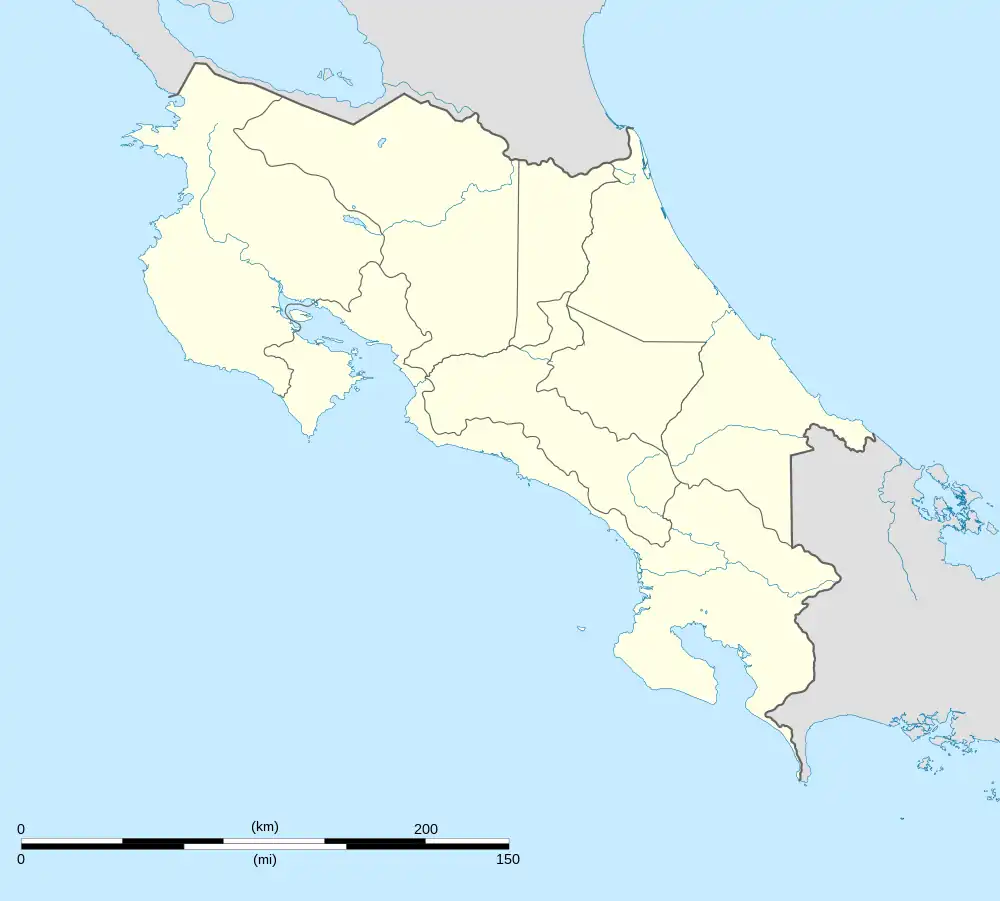Talamanca (canton)
Talamanca is a canton in the Limón province of Costa Rica.[2][3] The head city is Bribri, located in Bratsi district.
Talamanca | |
|---|---|
 Flag  Seal | |
Talamanca canton | |
 Talamanca Talamanca canton location in Costa Rica | |
| Coordinates: 9.4186631°N 83.0200471°W | |
| Country | |
| Province | Limón |
| Creation | 20 May 1969[1] |
| Head city | Bribri |
| Districts | |
| Government | |
| • Type | Municipality |
| • Body | Municipalidad de Talamanca |
| Area | |
| • Total | 2,809.93 km2 (1,084.92 sq mi) |
| Elevation | 29 m (95 ft) |
| Population (2011) | |
| • Total | 30,712 |
| • Density | 11/km2 (28/sq mi) |
| Time zone | UTC−06:00 |
| Canton code | 704 |
History
Talamanca was created on 20 May 1969 by decree 4339.[1]
Geography
Talamanca has an area of 2,809.93 km²[4] and a mean elevation of 29 metres.[2]
The county is noted for its beautiful beaches, especially in Cahuita and Puerto Viejo, which are popular tourist locations.
Talamanca contains one of Costa Rica's three official border-crossing points with Panamá, the Sixaola-Guabito crossing.
Districts
The canton of Talamanca is subdivided into the following districts:
Demographics
| Historical population | |||
|---|---|---|---|
| Census | Pop. | %± | |
| 1973 | 5,431 | — | |
| 1984 | 11,013 | 102.8% | |
| 2000 | 25,857 | 134.8% | |
| 2011 | 30,712 | 18.8% | |
|
Instituto Nacional de Estadística y Censos[5] |
|||
For the 2011 census, Talamanca had a population of 30,712 inhabitants.[7]
The county suffers from pervasive poverty. As of 2009, its human-development index is the lowest-ranked of all Costa Rican cantons.[8] While its most recent infant mortality rate is 12.89% (2009), it was as high as 22.5% (2003), and stayed above 15% between 2003 and 2007.[9] As of 2010, 52.3% of Talamanca inhabitants have access to sanitation (either piped or septic tank), and 75.2% are connected to electricity.[10]
The county is composed of four districts (see graphic below), with its capital city, Bribrí, located in the Bratsi district. Talamanca houses the largest indigenous population in the country (at 11,062, or 34% of the county's population), which is composed principally of the Bribri and Cabécar groups[11] (who in turn represent two of Costa Rica's eight distinct indigenous groups).[12] 31% of the district covers Talamanca's four indigenous reserves (Kekoldi, Talamanca Bribrí, Talamanca Cabécar, and Telire);
Transportation
Road transportation
The canton is covered by the following road routes:
Conservation
Eighty-eight percent of Talamanca's territory is protected. Fifty-five percent of this land falls under the Chirripó, Amistad, and Cahuita National Parks; and 2% belongs to the Jairo Mora Sandoval Gandoca-Manzanillo Mixed Wildlife Refuge (a major sea turtle nesting ground).[13]
In defense of these areas, for example, on July 27, 2011, the Ministerio de Ambiente, Energía y Telecomunicaciones (Minaet) carried out the demolition of two hotels (Las Palmas and Suerre), due to their occupation of 4 hectares of land within the Jairo Mora Sandoval Gandoca-Manzanillo Mixed Wildlife Refuge. [14]
See also
References
- Hernández, Hermógenes (1985). Costa Rica: evolución territorial y principales censos de población 1502 - 1984 (in Spanish) (1 ed.). San José: Editorial Universidad Estatal a Distancia. pp. 164–173. ISBN 9977-64-243-5. Retrieved 5 October 2020.
- "Declara oficial para efectos administrativos, la aprobación de la División Territorial Administrativa de la República N°41548-MGP". Sistema Costarricense de Información Jurídica (in Spanish). 19 March 2019. Retrieved 26 September 2020.
- División Territorial Administrativa de la República de Costa Rica (PDF) (in Spanish). Editorial Digital de la Imprenta Nacional. 8 March 2017. ISBN 978-9977-58-477-5.
- "Área en kilómetros cuadrados, según provincia, cantón y distrito administrativo". Instituto Nacional de Estadística y Censos (in Spanish). Retrieved 26 September 2020.
- "Instituto Nacional de Estadística y Censos" (in Spanish).
- "Sistema de Consulta de a Bases de Datos Estadísticas". Centro Centroamericano de Población (in Spanish).
- "Censo. 2011. Población total por zona y sexo, según provincia, cantón y distrito". Instituto Nacional de Estadística y Censos (in Spanish). Retrieved 26 September 2020.
- Álvaros, A.R. (2009, October 11). El miedo atracó en Limón. La Nación (Costa Rica). Retrieved from http://wvw.nacion.com/proa/2009/octubre/11/proa2113441.html
- Insituto Nacional de Estadística y Censos (INEC). (2009). Anuario Estadístico 2009. Retrieved from http://www.inec.go.cr
- Insituto Nacional de Estadística y Censos (INEC). (2010). Cuadro No 39: Indicadores de vividena, según provincia, cantón, y distrito. Retrieved from http://www.inec.go.cr
- Insituto Nacional de Estadística y Censos (INEC). (2008). Población estimada cerrada según provincia, cantón, y distrito al 31 de diciembre de cada año, 2002-2008. Retrieved from http://www.inec.go.cr
- Organización de las Naciones Unidas para la Eduación, la Cienca, y la Cultura (UNESCO). (2011). Grupos indígenas. Retrieved from http://www.unesco.or.cr/portalcultural/indigenas.htm
- Gudiño, Arturo (21 June 2007). "Denuncian actividad minera de extranjeros en reserva indígena de Costa Rica". La Nación (in Spanish). Retrieved 21 November 2020.
- "Imperio de la ley en Gandoca-Manzanillo". La Nación (in Spanish). 28 July 2011. Retrieved 21 November 2020.